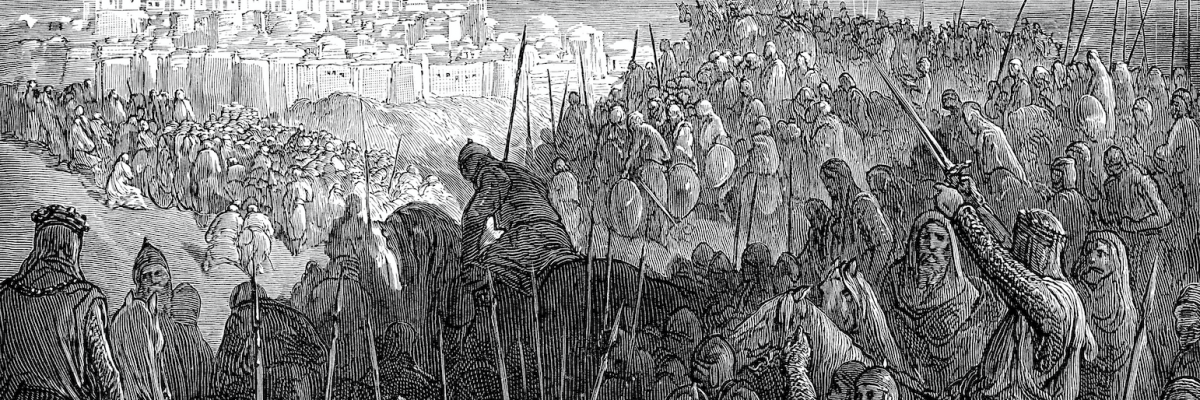
Last month (July 15) marked the 918th anniversary of the liberation of the Holy City by the warriors of Christendom on the First Crusade. It was a momentous event, and when news reached Christendom that the Crusaders had succeeded, there was much rejoicing. Those who returned home from the Crusade were feted as heroes and known as “Jerusalemites” for the rest of their lives.
The story of how the First Crusade succeeded is filled with personal heroics, sacrifice, and miraculous interventions throughout the journey. The real story has been obscured by the sensationalism and “Hollywood history” of our time, and the story should be set straight.
Those who entered the city in that summer of 1099 endured three years of battle, starvation, and disease in order to complete their armed pilgrimage at the Holy Sepulchre of the Lord. Eighty percent of their brothers in arms who marched from Europe with them were dead, missing, or had deserted. Those few who remained succeeded in accomplishing the task given to them by Pope Urban II (r. 1088-1099) in the fall of 1095: the liberation of Jerusalem.
The warriors of the First Crusade left the comfort of their homes and loved ones at the urging of Urban II. In November 1095, Urban preached the First Crusade at a Church council at Clermont. He called upon the warriors of Christendom to liberate the Holy Sepulchre of the Lord in Jerusalem and to stop the persecution of Holy Land Christians and Muslim harassment of Christian pilgrims from the West. Urban then traveled throughout France exhorting warriors to take the cross and participate in the armed pilgrimage.
It is estimated that 60,000 warriors responded to Urban’s call and made preparations to leave for the Holy Land. These warriors were organized into four main army groups commanded by Hugh of Vermandois, the younger brother of Philip I of France; Raymond of Toulouse; Godfrey de Bouillon; and the well-known warrior Bohemond. The groups left Europe separately and traveled overland to Constantinople where they encountered Emperor Alexius I.
Alexius was less than enthusiastic at their arrival and feared they would try to overthrow him. After receiving assurances the Christian warriors were more interested in liberating Jerusalem, Alexius transported the groups to Anatolia to begin the march to the Holy City.
After liberating Nicaea, the Crusader armies began the long march through Anatolia on their way to their second objective, Antioch. The Crusaders embarked on what became known as the Anatolian Death March during the high summer heat. Food and water were scarce, and horses died in droves. Men even died of hyponatremia (water intoxication) after drinking too much water too fast when fresh sources were found. Count Raymond of Toulouse became so ill that, fearing death was near, he received the sacrament of extreme unction.
Adding to their suffering on the march, the Crusaders were attacked by an allied Muslim force near the town of Dorylaeum. Despite their weakened condition, the Christian warriors fought well and under the leadership of Bohemond defeated the Muslim army. News of the victory spread throughout the region and contributed to the belief that the Christian force was invincible.
After the grueling four-month march through Anatolia, the Crusaders arrived at the ancient Christian city of Antioch where they settled in for a long siege. Antioch was a heavily defended city with a massive wall, and the Crusader force was too small to fully encircle the city.
The siege wore on, and as casualties mounted, the city was eventually breached through a plan concocted by Bohemond, who successfully bribed one of the tower guards to allow the Crusaders entry into the city unmolested. Although the Crusaders were in control of the city, the citadel remained in Muslim hands and only one day after the Crusaders captured Antioch, a large Muslim relief army under the command of Kerbogha arrived at the walls. The Christian warriors were caught between the Muslim-held citadel inside the city and the large Muslim army outside the walls.
The long siege was costly, and morale was exceptionally low. Many believed this was the end of the Crusade, but God intervened and morale was restored when the relic of the Holy Lance (the spearhead used by St. Longinus to pierce the Lord’s side as he hung on the cross) was found in a church after the layman Peter Bartholomew received visions about its location.
Emboldened by the finding of the relic, the Crusaders launched a surprise offensive on the Muslim relief army outside the walls of Antioch. Veterans of the battle recalled seeing angels and the spirits of dead Crusaders riding into combat with the living. The Crusaders were exhausted after their miraculous victory over a numerically superior foe and spent the next several months resting and preparing for the assault on Jerusalem.
The remnant of the First Crusade armies arrived 12,000 strong at the city walls of Jerusalem on June 7, 1099. They spent the next six days building their siege camp and reconnoitering the defenses of the city. After failed attacks, the situation was desperate as news of a Fatimid relief army on the march reached the Crusader camp. The Crusaders were now engaged in a race against time.
The siege was saved when a priest, Peter Desiderius, shocked the warriors with an announcement that he had seen a vision of Bishop Adhemar, the papal legate who had died shortly after the final victory at Antioch. According to his testimony, Adhemar was upset at the lack of unity among the Crusade leaders and indicated the Holy City could fall only with a show of penance by the Crusaders. He demanded they fast for three days and then process barefoot and unarmed around Jerusalem.
On July 8 the Christian host processed around the Holy City singing prayers and bearing relics, including the Holy Lance from Antioch. The Muslim defenders mocked the Crusaders’ imitation of Joshua and the Israelites at Jericho by hanging crosses over the walls while hitting and abusing them.
A week later at 3 p.m., the hour of the Crucifixion, the Crusaders achieved their final objective and entered the Holy City of Jerusalem. Much has been made of the “Massacre of Jerusalem” after the Crusaders entered the city. While it is true the Crusaders killed thousands in the city (combatants and non-combatants), tens of thousands were captured, ransomed, or fled. The dictates of warfare at the time, followed by Christians and Muslims alike, allowed victorious siege armies free reign once the city fell. This is why many cities accepted conditional surrender when armies first appeared at the walls.
Their three-year armed pilgrimage complete, most Crusaders decided to return home. Some stayed and decided they needed to protect, organize, and consolidate the liberated territory. In order to accomplish this, they needed a strong leader, so they decided to appoint a king. The choice eventually fell to Godfrey de Bouillon, who refused the title “king,” choosing instead the moniker “Defender of the Holy Sepulchre.” In explaining his choice of titles, Godfrey reportedly said that he refused to wear a crown of gold in the city where his Savior wore a crown of thorns.
For more exciting reading on the real history of the Crusades, please see my book The Glory of the Crusades.



